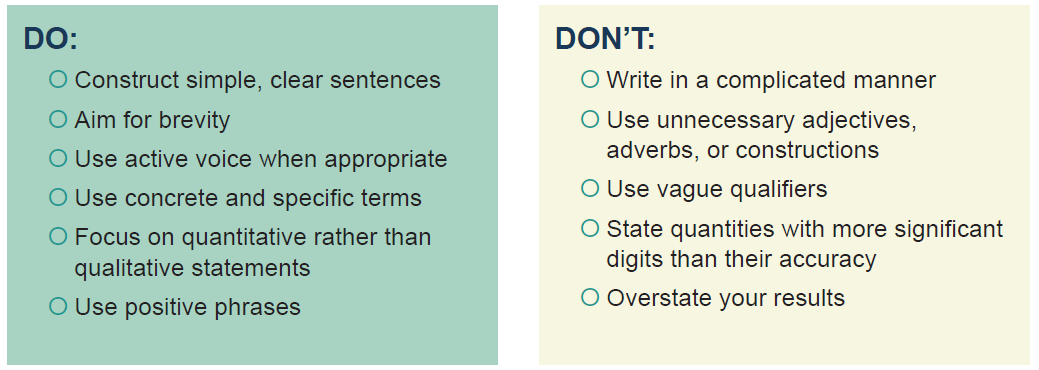Want to share your screen? See the person you're talking to? Contact us via digital library desk! We will be with you shortly.
Monday-Friday


Want to share your screen? See the person you're talking to? Contact us via digital library desk! We will be with you shortly.
Monday-Friday


Scientific writing serves as the bridge between conducting research and communicating with the public. Translating complex research ideas and processes into a clear, concise document is a difficult but essential component of the scientific process.
Starting can feel daunting, but we encourage you to begin the writing process early in your research journey and allow the research and writing to be integrated. By outlining methods, drafting sections and organising concepts, the writing process will be more manageable, but it can also improve your research by organising your own thoughts throughout the process. Below, we provide some resources and tips to help make your writing process easier.
Components of scientific writing
Like riding a bike, developing your own scientific writing style takes practice. Our recommendation to find your personal style is to keep reading scientific articles, noting which articles you enjoy and which you don't, and to keep writing! While scientific writing can vary dramatically from author to author, here are some common do's and don'ts.

Recommended resources:
There are many ways to approach writing a cohesive and easy-to-follow manuscript. The Context-Content-Conclusion (C-C-C) scheme is one way to help increase coherence within your paper.
The advantage of using this scheme is that it allows readers to follow the flow of your paper (e.g. with the sandwiching of the context and conclusion), even when they struggle to understand every detail (portions of the content). This helps broaden the reach of your work by making it understandable to those outside your field.
Recommended resources:
Many scientific articles have similar components. Each section serves a role in sharing your research with the community. Here are some of the common components and their purpose:
| Section | Purpose |
|---|---|
| Title | Concise, specific and engaging phrase |
| Key points/Highlights | Conveys the main contribution |
| Abstract | Standalone summary |
| Plain language summary/Layman summary | Explains your reserach to a broader audience |
| Introduction | Set up the context and importance of your objectives |
| Methods | Highly detailed procedure |
| Results | Findings without interpretations |
| Figures & tables | Communicate complex information |
| Discussion | Interpretation and evaluation of your results |
| Conclusion | Wrap up |
Recommend resources:
In scientific writing, the verb tense changes throughout the manuscript. Here are the typical recommendations for verb tense in each section, but we recommend looking at literature in your field as a reference.
| Section | Verb tense |
|---|---|
| Title | Present |
| Key points/Highlights | Present |
| Abstract | Present |
| Plain language summary/Layman summary | Present |
| Introduction | Present (sometimes past tense is used when describing previous work) |
| Methods | Past (present tense can be used when describing a new methodology) |
| Results | Past |
| Figures & tables | Present |
| Discussion | Present and past (and future when discussing next steps/future work) |
| Conclusion | Present |
Recommended resources:
Stuck on a section? Writing paralysis? We've all been there. Here are a few things to try if you are experiencing writer's block:
Stuck on a specific sentence or word? Can't figure out how to say something?
Recommended resources:
Formatting your manuscript is a necessary hurdle. Here are our recommendations:
Scientific manuscripts are rarely the product of a single individual and often reflect the contributions of many people. Determining who qualifies for authorship, however, can be complex. We recommend discussing authorship expectations early on with your PI or advisor and the potential co-authors.
Many journals now promote authorship transparency by allowing (or requiring) authors to specify individual contributions. One widely used framework is the Contributor Role Taxonomy (CRediT), which defines specific roles authors may have played in the research and writing process. Authors can be identified as one (or more) of the following:
For more information and a detailed explanation of each role, please review the ANSI/NISO standard here.
Finished up writing and wondering how you tackle getting it published? Or just wondering what comes after writing? Either way, check out our Scientific publication page to set yourself up for pushing your manuscript through the publication process.
AI tools - large language models (LLMs) in particular - can help in the preparation of scientific manuscripts. At the same time, their use raises concerns regarding research integrity and accountability. In response, most academic publishers have introduced policies regarding the use of AI tools by authors.
These policies are evolving rapidly, reflecting the fast pace of developments in AI technologies. Therefore, we advise you to consult the current author guidelines of your journal of interest and to contact the editorial office in cases of uncertainty.
Despite differences in the details of these guidelines, some general principles are common across many publishers:
AI tools cannot be listed as authors. Authorship implies responsibility and accountability for the content of a publication, which cannot be delegated to software or automated systems. You as author remain fully responsible for the accuracy, originality, and integrity of their work.
The use of AI tools for figure or image generation is often restricted or prohibited. Existing rules on image manipulation apply equally to AI-generated or AI-modified images. In many journals, the use of AI is also limited or prohibited for graphical abstracts, schematics, or illustrative cartoons.
Transparency is expected whenever AI tools are used. Even when permitted, most journals require authors to disclose the use of AI tools or LLMs (for example, for text editing or language refinement). Disclosure requirements and formats vary and should be checked in the journal’s “Instructions for Authors".